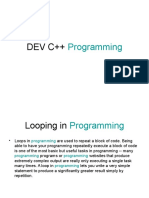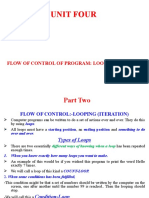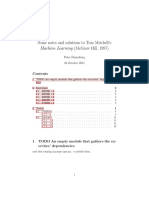Computer Fundamentals and Programming - Module 04
Uploaded by
Joel ManacmulComputer Fundamentals and Programming - Module 04
Uploaded by
Joel ManacmulModule 04
Computer Fundamentals
and Programming
ENGR. JOEL D. MANACMUL
Department of Engineering and Architecture
Bataan Heroes College
This module or any portion thereof may not be reproduced or used in any manner whatsoever without
the express written permission of the publisher except for educational purposes but with a citation to this
source.
For Permission: Contact Bataan Heroes College, Roman Super Hi-way, Balanga City, Bataan, Philippines
Computer Fundamentals and Programming Page 2 of 10
Engr. Joel D. Manacmul
Bataan Heroes College
Course Information
Course Title : Computer Fundamentals and Programming
Program : Business & Technology
Course Code : Comp 101
Credit Units : 3 units
Pre-requisite/s :
Instructor Information
Name : Engr. Joel D. Manacmul
Contact Information
Contact Number : 09281421172
Facebook : Joel Manacmul
Email : hoel07@gmail.com
Course Description
In the course, students would understand the basic components of computers (hardware and
software), information systems, and electronic data processing. The course emphasizes on program
development, which includes use of pseudocode in problem-solving and formulation of
algorithms. High level language and programming applications like C++; computer solutions of
engineering problems. .
Intended Learning Outcomes
Identify various computer applications
Familiarize with the operations or process in computer from raw facts to useful output
Explain the characteristics of input/output and storage components of computer
Know the difference and relevance of software and hardware
Computer Fundamentals and Programming Page 3 of 10
Engr. Joel D. Manacmul
Bataan Heroes College
Course Schedule
Week Topic
Basic Components of Computer
o Definition of computer
Week 1 o Computer Application
Module 1 o Operations in computer
o Components of computer
Hardware and Software
Introduction to Programming
Week 2 o What is C++
Module 2 o Installation
o Coding
MIDTERM ASSESSMENT
Week 3 Operators in C++
Module 3 Conditional Statements
Week 4
Loop Statements
Module 4
Week 5
Array
Module 5
FINAL ASSESSMENT
Computer Fundamentals and Programming
Objectives:
Working on this module should help you to:
Code basic C++ language.
Demonstrate familiarity with major events in computer history and apply their lessons to
current and future technological and social developments.
Apply problem-solving and critical-thinking skills in collaborative contexts.
Utilize technology in pursuit of intellectual growth and efficacious human interaction.
Explore and research applications of computers and computing in their daily lives.
Computer Fundamentals and Programming Page 4 of 10
Engr. Joel D. Manacmul
Bataan Heroes College
Reference
Learn Computer Fundamentals basic of Computers. Tutorial Points. Retrieved July 29, 2020 from
https://www.tutorialspoint.com/computer_fundamentals/index.htm
Parson , J. Oja, D. (2011). New Pespective on Computer Cocpets 2012: Comprehensive (14th ed).
Massachusetts, USA: Course Technology
Module 4: Loop Statements
Loop – Allows us to execute a statement or group of statements multiple times.
Types of Loops
A. While Loop – Repeats a statement or group of statements while a given condition is true.
It tests the condition before executing the body.
Syntax:
while (condition)
{
Statement
}
Example: Output
Computer Fundamentals and Programming Page 5 of 10
Engr. Joel D. Manacmul
Bataan Heroes College
Explanation:
int a; - We declared a variable named a with the data type int, meaning it can handle only whole
numbers or integer. Note that if we declared a variable and we didn’t assigned a value its default
initial value is 0. But for example we declared like this int a=5; we declared a as integer with 5 as
its initial value.
while (a<=20)
{
Cout<<”Value of a: “ <<a<<endl;
a++;
}
We will display the string “Value of a” together with the value of a while its value is less than or
equal to 20. Meaning instead we print the text using cout in multiple times, we used loop
specifically while loop to print the string multiple times while the condition is true.
a++ - is the code that will increment the value of a by 1 as the statement loops or repeats.
B. Do – While Loop – It is like a while statement, except that it test the condition at the end of the
loop body.
Syntax:
do
{
Statement
}
while (condition)
Example: Output
Computer Fundamentals and Programming Page 6 of 10
Engr. Joel D. Manacmul
Bataan Heroes College
int a; - We declared a variable named a with the data type int, meaning it can handle only whole
numbers or integer.
do
{
Cout<<”Value of a: “ <<a<<endl;
a++;
}
while(a>=20)
It’s the same thing with while condition, it has the same purpose which is to run a specific
statement or group of statements multiple times depending on the condition given. It’s just that in
do while we will execute first the statement (statement under do) before we check the condition
(condition inside wile).
We will also display the string “Value of a” together with the value of a while its value is less
than or equal to 20.
a++ - is the code that will increment the value of a by 1 as the statement loops or repeats.
C. For Loop – execute a sequence of statements multiple times and abbreviate the code that manages
the loop variable
Parts of For Loop
1. Int – execute first and inly once
- Allows you to declare and initialize any loop control variable
2. Condition – if it is true, the body of the loop will be executed
- If it is false, the body of the loop does not execute and flow of control jumps to the next
statement after the loop
3. Increment – After the body of the loop executes, the flow of control jumps back up to the
increment statement.
Syntax:
for (int; condition; increment)
{
Statement
}
Computer Fundamentals and Programming Page 7 of 10
Engr. Joel D. Manacmul
Bataan Heroes College
Example: Output:
Explanation:
int a=1; - this is our init r initialization. We decalred a vriable with 1 as its initial value
a<=20; this is the condition of our loop. Meaning the statement inside the body of loop will
execute while this condition is true.
a++ - the value of variable will increment by 1 as the statement loops or repeats.
for (int a=1; a<=20; a++)
{
cout<<"Value of a: "<<a<<endl;
}
Meaning, we will print the string “Value of a” with the value of a, and the initial value of a is 1,
so when the string execute for the first time the first value of a is 1, when the string will execute
again the value of a now is 2, it is because we have incrimination in the for loop. The value of a
will increment by 1 as the statement loop while a is less than or equal to 20.
D. Goto Loop – When encountered, program flow jumps to the location specified by goto
- The goto requires a label
- Label is a valid C++ identifier followed by colon
Syntax:
loop_name:
statement;
Computer Fundamentals and Programming Page 8 of 10
Engr. Joel D. Manacmul
Bataan Heroes College
Example: Output:
Explanation:
Int a= 1 – We declared a variable named a with initial value of 1.
loop:
cout<<"Value of a: "<< a <<endl;
a++;
Our loop/label name is loop, again you are the one who will name the label. Under our
loop we will display the string Value of a with the value of a. And as the loop repeats its
execution the value of a will increment by 1.
if(a<=20)
{
goto loop;
}
We used if statement to compare the value of a if it is less than or equal to 20. Since our loop
will increment by 1 as it repeats its execution, we compare the value of a to 20. If the value of a is
less than or equal to 20, the program flow will jump to the loop. If the value of a will become
greater than 20 the program will be terminated.
Computer Fundamentals and Programming Page 9 of 10
Engr. Joel D. Manacmul
Bataan Heroes College
E. Nested Loop - You can use one or more loop inside any another loop.
Example: Output:
Explanation:
When the first for loop is executed, the value of i is 1 and "Table of 12" gets
printed. Now coming to the second loop, the value of j is 1 and thus 1*1 = 1 gets printed.
In the second iteration of the inner for loop, while the value of i is still 1, the value
of j becomes 2 and thus 1 * 2 = 2 gets printed. In the last iteration of the inner for loop,
the value of i is still 1 and the value of j becomes 10, thus printing 1 * 10 = 10.
Now after all the iterations of the inner for loop are complete, there will be the second
iteration of the outer for loop increasing the value of i to 2 and printing Table of 2. Again
the inner for loop will be iterated with i equals 2. And so on, and so on.
We can use any loop inside any other loop according to the requirement. In the above
example, we used one for loop inside another.
Infinite Loop - There may exist some loops which can iterate or occur infinitely. These are called Infinite
Loop. These loops occur infinitely because their condition is always true.
Computer Fundamentals and Programming Page 10 of 10
Engr. Joel D. Manacmul
You might also like
- Introduction To Computer and ProgrammingNo ratings yetIntroduction To Computer and Programming21 pages
- Assignment C++ (Nur Syahira Binti Mohd Sa'ady)No ratings yetAssignment C++ (Nur Syahira Binti Mohd Sa'ady)14 pages
- For Loop: - The Most Popular Looping Instruction - The For Loop Allows Us To Specify Three Things in A Single LineNo ratings yetFor Loop: - The Most Popular Looping Instruction - The For Loop Allows Us To Specify Three Things in A Single Line17 pages
- Assignment C++ Programming: Syntax of Goto StatementNo ratings yetAssignment C++ Programming: Syntax of Goto Statement10 pages
- Loops: The Increment and Decrement Operators: Val++ Val Val + 1 ++val Val++No ratings yetLoops: The Increment and Decrement Operators: Val++ Val Val + 1 ++val Val++19 pages
- Assignment C++ Muhammad Amirul Affandi Bin RosliNo ratings yetAssignment C++ Muhammad Amirul Affandi Bin Rosli8 pages
- CS-114 Fundamentals of Computer Programming: Control Statements - IVNo ratings yetCS-114 Fundamentals of Computer Programming: Control Statements - IV51 pages
- CS-114 Fundamentals of Computer Programming: Control Statements - IIINo ratings yetCS-114 Fundamentals of Computer Programming: Control Statements - III34 pages
- Assigment: C++ Programming: 1.who Is Written C++No ratings yetAssigment: C++ Programming: 1.who Is Written C++7 pages
- CHAPTER 8 C++ ITERATION REPETITION STRUCTURENo ratings yetCHAPTER 8 C++ ITERATION REPETITION STRUCTURE7 pages
- Department Information Techonology: Subject: Object Oriented Programming Lab ManualNo ratings yetDepartment Information Techonology: Subject: Object Oriented Programming Lab Manual25 pages
- Conditions, Switch, While Loop, and For LoopNo ratings yetConditions, Switch, While Loop, and For Loop22 pages
- (Document Title) : Government Postgraduate College JhangNo ratings yet(Document Title) : Government Postgraduate College Jhang73 pages
- Decision Making & Looping: Program Loop: Control StatementNo ratings yetDecision Making & Looping: Program Loop: Control Statement27 pages
- Loops: Control Structures II (Repetition) Introduction To Programming Dr. Sajid KhanNo ratings yetLoops: Control Structures II (Repetition) Introduction To Programming Dr. Sajid Khan53 pages
- Computer Fundamentals and Programming - Module 03No ratings yetComputer Fundamentals and Programming - Module 0318 pages
- OJT Instructions (System Proposal With Feasibility Study)No ratings yetOJT Instructions (System Proposal With Feasibility Study)7 pages
- Computer Fundamentals and Programming - Module 05No ratings yetComputer Fundamentals and Programming - Module 057 pages
- COEN 3193 (Data Communications) - Chapter 1No ratings yetCOEN 3193 (Data Communications) - Chapter 180 pages
- Computer Fundamentals and Programming - Module 01No ratings yetComputer Fundamentals and Programming - Module 0122 pages
- Data and Digital Communication - Module 01No ratings yetData and Digital Communication - Module 016 pages
- Science, Technology & Society - Module 01No ratings yetScience, Technology & Society - Module 0118 pages
- CpE Laws - Professional Practice - Module 02No ratings yetCpE Laws - Professional Practice - Module 0216 pages
- CpE Laws - Professional Practice - Module 04No ratings yetCpE Laws - Professional Practice - Module 0417 pages
- CpE Laws - Professional Practice - Module 05No ratings yetCpE Laws - Professional Practice - Module 0525 pages
- Computer Engineering Orientation - Module 04 - 05No ratings yetComputer Engineering Orientation - Module 04 - 059 pages
- CpE Laws - Professional Practice - Module 01100% (1)CpE Laws - Professional Practice - Module 0129 pages
- Computer Engineering Orientation - Module 01100% (1)Computer Engineering Orientation - Module 0115 pages
- Protect Your Intellectual Property: Bataan Heroes CollegeNo ratings yetProtect Your Intellectual Property: Bataan Heroes College2 pages
- Computer Engineering Orientation - Module 03No ratings yetComputer Engineering Orientation - Module 038 pages
- Computer Engineering Orientation - Module 02No ratings yetComputer Engineering Orientation - Module 0211 pages
- Introduction To Intellectual Property - Module 04 - 05No ratings yetIntroduction To Intellectual Property - Module 04 - 0515 pages
- Introduction To Intellectual Property - Module 02No ratings yetIntroduction To Intellectual Property - Module 0212 pages
- Time Driven Activity Based Costing An ImNo ratings yetTime Driven Activity Based Costing An Im51 pages
- GR 12 Climate and Weather - Tropcial CyclonesNo ratings yetGR 12 Climate and Weather - Tropcial Cyclones12 pages
- Cambridge International AS & A Level: BIOLOGY 9700/32No ratings yetCambridge International AS & A Level: BIOLOGY 9700/3216 pages
- Handbook Statistical Foundations of Machine LearningNo ratings yetHandbook Statistical Foundations of Machine Learning267 pages


















































































































